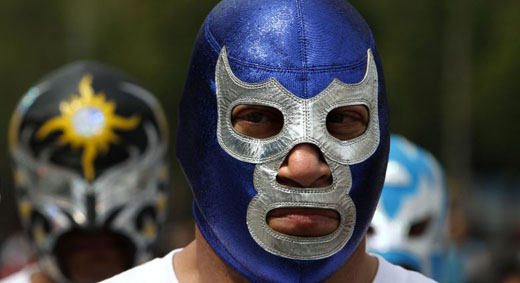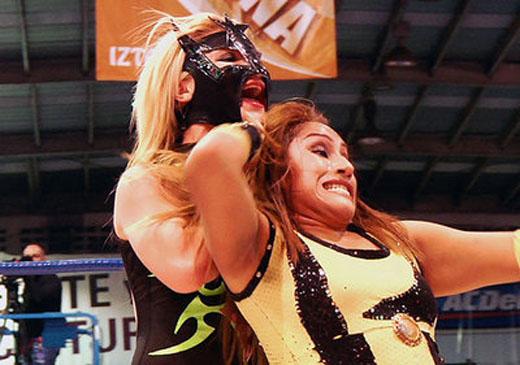Review: Lucha Mexico (2016)
Directors Alex Hammond and Ian Markiewicz were granted unprecendented access to the “empresas” or promotions behind the tradition-heavy and color world of lucha libre, or Mexican professional wrestling. The result is the documentary Lucha Mexico, concentrating heavily on the history of Mexico’s biggest wrestling stadium, Arena Mexico, in Mexico City, and CMLL, the promotion that runs it. Find out our thoughts about the documentary after the jump.
Documentaries on pro wrestling like 2016’s The Resurrection of Jake The Snake Roberts and 1999’s Beyond the Mat tend to focus on the colorful performers that compete in the pseudo-sports squared circle. Oftentimes more colorful than the storylines and culture itself, Lucha Mexico takes a similar tack. focusing on several performers within Mexico’s CMLL promotion; Shocker, an aging wrestler who bills himself as 1000% “guapo” (handsome) and his friend Fabian, a fellow wrestler who runs a gym for wrestlers and struggling to find his place in the sport after losing his masked identity in a match. We also meet Jon “Strongman” Andersen, a bodybuilder from the U.S. hoping to make a name for himself in Mexico based on his physique, and El Hijo De Perro Aguayo, a savvy 2nd generation wrestler who runs an independent promotion and store to market himself in the style of the U.S. promotion WWE.
The documentary does well when it covers these wrestlers’ journeys and gives us the perspective of their life on the road. Shocker suffers a devastating injury; but we see that he already plans for life outside of the ring with a taco restaurant and seeing his interactions with people while buying supplies at Costco gives us a glimpse at what it is like to walk in their shoes. Strongman’s storyline shows us how he is trying to balance family life with making money as a wrestler and bodybuilder. The best segments tend to be those that focus on the history of lucha libre. We get to see Blue Demon Jr., the son of one of Mexico’s most famous luchadores talk about his father’s importance to Mexican film and wrestling culture and how their relationship led to Jr. assuming his father’s mantle when he retired. Its sad that we see many shots of El Hijo Del Santo, the son of Mexico’s greatest wrestler, yet we don’t have a similar scene with him for context. Especially striking is teh story of Fabian, Shocker’s friend, who seems to be happy in his role as a masked luchador and gym owner. Once he loses his masked identity, he seems lost and we learn later that he passed away due to a combination of alcohol and pain killers. A sad and affecting chapter in the film.
The fault with Lucha Mexico mainly lies in the wealth of access and footage Hammond and Markiewicz have at their disposal. Rather than providing a historical context for lucha and explaining its growth, the filmmakers sort of follow random threads here and there in the documentary. They interview a midget wrestler named Kemonitos, a mascot type character for CMLL who participates in matches and is an icon for children. However, the importance of minis as they are known in wrestling culture isn’t touched upon much expect in a small mention later in the documentary. The CMLL promotion is the main one followed in the film; but we talk with the owner of AAA, the WWE of Mexico for a brief period and the relationships between wrestlers and their ability to work between promotions is not addressed in the film. We know from the segment with El Hijo Del Perro Aguayo’s segment that there are independent wrestlers who wrestle outside the 2 main promotions covered and this would’ve been interesting to see covered. The documentary would have benefited from a narrative voice to give the viewer perspective; especially given that this is a subset of a rich foreign culture.
There os also so much missed opportunity in this documentary. It was national news when El Hijo De Perro Aguayo died in the ring. He is an active participant in the film and his death is touched on in a very strong segment with one of his partners Damian 666. However, he is a side character at best in the film and we don’t learn much from him except his business savvy as an independent promoter. We don’t get to talk to anyone involved in the match to see what effect this has on the wrestlers besides his partner. Blue Demon Jr’s strong segment gives us some backstory on the lucha libre scene in Mexico, but there’s not a lot of content given in the film minus some scenes from an announcer in Mexico City giving us the history of CMLL and Arena Mexico. More of that would have been a boon to the film.
Overall, the documentary is beautifully shot and even though its not the definitive documentary on lucha libre it could have been, Lucha Mexico is still worth a watch. We meet many luchadors in brief scenes that gives us a view why many would choose this lifestyle. From its empowering role in the lives of the performers like Faby Apache, to how it saved the lives of others like Sexy Star, we see lucha in its many roles in life and culture and its importance in Mexico, making Lucha Mexico very captivating in that sense.




